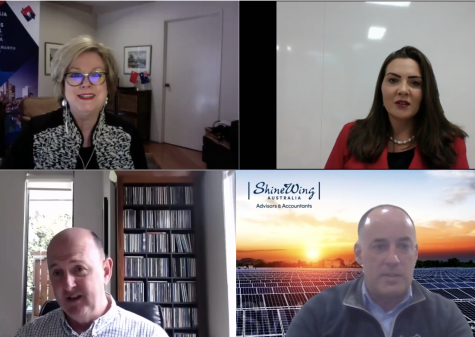Australia’s Energy Future – Hydrogen | ACBC Vic & CSIRO
Wed 30 September – This online seminar saw expert panellists Patrick Hartley (CSIRO) and Andrea Galt (Woodside Energy) discuss the changing nature of Australia’s energy sector.
With their industry and research expertise in hydrogen, Patrick and Andrea answered a range of questions related to the multi-faceted hydrogen sector in Australia including research, development, production, storage and facilitation of hydrogen energy, as well as collaborations with China in this growth sector.
Thank you to ShineWing Australia for their generous support and ACBC Vic President Matthew Schofield for his moderation of the Q & A session.
Key Takeaways
CSIRO
- The hydrogen industry could generate about 8 thousand jobs by 2050, $11 billion a year in GDP, reduce Australia’s greenhouse gas emissions by up to 135 million tonnes by 2050.
- CSIRO supports the vision of a clean and competitive hydrogen industry in 3 main ways:
-
- working with government and industry stakeholders to provide trusted advice that is required to create informed investment decisions.
- Investing in its own strategic research funds to develop new technologies.
- Make sure technologies are commercialised and reach the market through active partnerships within the industry.
- CSIRO has undertaken a Hydrogen Industry Mission project
Woodside Energy
- Woodside Energy has been working on the New Energy Team for the past 3 years.
- Expects to see large scale hydrogen production around the world by 2030.
- Focussing on the production of both blue and green hydrogen:
- Blue hydrogen is made from natural gas through a process of reforming. Although it does release carbon emissions, Woodside is committed to managing these through offsets or technical abatement to offer a carbon-neutral product.
- Green hydrogen is produced from water through an electrolyser with renewable power.
Panel Questions
What will be the key drivers for hydrogen to be available at service stations and hydrogen vehicles to become widespread?
-
- The major driver will be the roll-out of cost-competitive technologies that can facilitate the use of hydrogen vehicles in society.
Is the government truly supportive of hydrogen as a future major fuel source? Is the government doing enough to support it, or should it be doing more?
-
-
- Yes, the government has shown that they are committed, proven through the release of the National Hydrogen Roadmap and National Low Emmission Roadmap.
- Many states are currently working on their own hydrogen strategies.
-
What is Australia’s competitive advantage in becoming a world leader in hydrogen?
-
- Australia is an excellent location for hydrogen to be exported from, due to the stable government, technology roadmaps and funding.
- Australia has excellent renewable resources.
- Australia is supportive of foreign investment.
What are the main barriers to a hydrogen economy in Australia compared to Europe/China etc?
-
- In Australia, it can be harder to get researchers and technology up and going, however Australia is known to punch above its weight when it comes to the technology that is produced.
- The location of Australia may make it difficult to produce on a global scale.
What are the materials and manufacturing challenges related to the use of hydrogen going forward?
-
- High infrastructure costs are due to only being an emerging market.
- There are several materials challenges that need to be addressed, such as how hydrogen reacts with metal – therefore solutions need to be created to solve the issues that are showing up.
In which form are you planning to store the hydrogen?
-
- There are multiple ways:
- It can be liquefied.
- It can be stored in a different form of a liquid organic hydrogen carrier. By adding another chemical like toluene, it can be transported and stored as another chemical
- Also using ammonia.
- Differentiation between carbonised hydrogen vs green hydrogen.
- The desire to get green hydrogen in order to minimise carbon emissions.
- Australia is a fantastic location to make hydrogen. We have high-class wind and solar energy sources.
- Water is necessary to make hydrogen – although this may be difficult in some parts of Australia.
- There are multiple ways:
Are there any trials or projects that are being undertaken locally, and what’s your views on future education and training requirements?
-
-
- From an education standpoint, we can look to Europe, Japan and Germany, and talk with and learn from other countries and sectors who are further advanced in their hydrogen economy than Australia is.
-
Government grants, and CSIRO support and collaboration. Is this happening?
-
-
-
- Key part of CSIRO’s work is creating partnerships.
- The government is constantly announcing new funding programs.
-
-
Have you given much thought into existing infrastructure as a way of lowering costs?
-
-
- Finding a location is very important. It needs to be a suitable space for production, and also an appropriate location for transport.
-
Are you seeing many partnerships with China in regard to leveraging each other’s skillsets?
-
-
- Woodside is talking to partners in China, as leveraging of each other is how we can excel in the transition to hydrogen.
- The Chinese Academy of Sciences and CSIRO working together:
- A joint research program.
- Working through joint areas of RND
- Focussed on the production and storage side of the research
- Huge expertise in both China and Australia.
- Partnerships between Chinese universities and Woodside
-
- Monash has a campus in China, and therefore Woodside has access through this partnership.
-
-
Takeaways compiled by Annabel Pittendrigh

